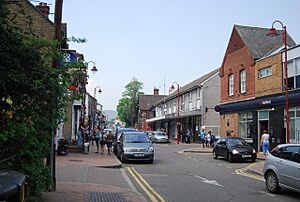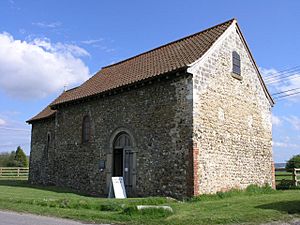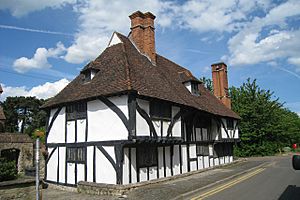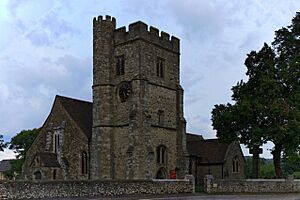Snodland facts for kids
Quick facts for kids Snodland |
|
|---|---|
 High Street |
|
| Population | 10,211 (2011 Census) |
| OS grid reference | TQ699514 |
| District | |
| Shire county | |
| Region | |
| Country | England |
| Sovereign state | United Kingdom |
| Post town | SNODLAND |
| Postcode district | ME6 |
| Dialling code | 01634 |
| Police | Kent |
| Fire | Kent |
| Ambulance | South East Coast |
| EU Parliament | South East England |
| UK Parliament |
|

Snodland is a town in Kent, England. It is part of the Tonbridge and Malling area. The town sits by the River Medway, between the cities of Rochester and Maidstone. It is about 34 miles (55 km) from central London. In 2011, Snodland had a population of 10,211 people.
Contents
- What is the History of Snodland?
- Where is Snodland Located?
- What is the Economy of Snodland?
- What is the Culture and Community Like?
- What are the Main Landmarks in Snodland?
- How Do People Get Around in Snodland?
- What Media is Available in Snodland?
- What Schools are in Snodland?
- What Religious Sites are in Snodland?
- What Sports are Played in Snodland?
- Who are Some Famous People from Snodland?
- See also
What is the History of Snodland?
How did Snodland get its name?
The name "Snoddingland" was first written down in a document from 838 AD. In this document, King Egbert of Wessex gave land in "Snoddingland" to the Bishop of Rochester. The name likely means 'cultivated land belonging to Snodd' or Snodda. Later, in the Domesday Book of 1086, it was called "Esnoiland."
Roman Times and Early Crossings
Historians believe that the Romans might have crossed the River Medway near Snodland. This was during their first push to conquer Britain. A special marker on the other side of the river, near Burham, shows this possible crossing spot. Later, a ferry here helped pilgrims travel to Canterbury along the famous Pilgrims' Way.
Building and Industry Growth
For many centuries, people in Snodland worked with lime. This material is used in building. In the 1800s, this industry grew a lot because many new buildings were being built. Companies like William Lee started quarrying lime here. Lime from this area was even used to build famous London bridges, like Waterloo Bridge.
Around 1740, the paper-making industry also came to Snodland. A family named May built a paper mill. New ways of making paper and the arrival of the railway in the 1850s helped paper production grow quickly.
The Railway Arrives
The railway opened in Snodland on June 18, 1856. This made the village grow very fast. Between 1861 and 1881, Snodland's population tripled! Because of this growth, the town's borders were changed in 1898 and again in 1988.
Modern Development
Today, Tonbridge and Malling Borough Council has a plan to develop and expand the Holborough part of Snodland. Since 2005, a company called Berkeley Homes has been building about 1,200 new houses in the area where the Holborough Quarry used to be.
Where is Snodland Located?
Snodland is located between the North Downs hills to the west and the River Medway to the east. To the south, you'll find Leybourne Lakes Country Park. This park was made from old gravel pits that are now filled with water. They are used for fishing and are home to wildlife. Across the river is the Burham Marsh nature reserve, which is a special area of tidal reed bed.
What is the Economy of Snodland?
Since 1903, Snodland has been home to the Mid Kent Water Company. This company later joined with South East Water. Now, it's called South East Water. The company provides water to over 2 million customers. These customers live in Kent, Sussex, Surrey, Hampshire, and Berkshire.
What is the Culture and Community Like?
Since 1986, Snodland has been a twin town with Moyeuvre-Grande. This is a town in North East France, near Metz. The two towns often celebrate their partnership.
Snodland has two public houses, which are like local pubs: The Freemasons Arms and The Monks Head. There are also two working men's clubs: Snodland WMC and Ham Hill WMC.
What are the Main Landmarks in Snodland?
A Roman villa in Church Field has been partly dug up by archaeologists. Besides the churches, Woodlands Farmhouse on Constitution Hill is a very old building from the 1400s. The Mulberry Cottages on the High Street are also very old, dating back to around 1450. There's even a mock ruin built around 1850 near the water company headquarters.
How Do People Get Around in Snodland?
Roads
The town is on the A228 road. This road connects the Medway Towns with Tonbridge. The M20 motorway is only two miles south of Snodland. This motorway makes it easy to get to London and the Channel Ports. A special road called the Snodland by-pass helps keep heavy trucks out of the town centre.
Railway
The railway station opened on June 18, 1856. It is part of the Medway Valley Line. You can catch trains that go directly to St Pancras in London during busy times. Otherwise, you can change trains at Strood or Maidstone Barracks/Maidstone East to reach London.
What Media is Available in Snodland?
Local news and TV shows for Snodland are provided by BBC South East and ITV Meridian. You can also get BBC London and ITV London from other transmitters.
For radio, you can listen to BBC Radio Kent on 96.7 FM, Heart South on 103.1 FM, Gold Radio on 1242 AM, and KMFM Maidstone on 105.6 FM. The local newspaper for the town is the Kent Messenger.
What Schools are in Snodland?
The Holmesdale School is a secondary school that used to be called Holmesdale Technology College. It still focuses on technology. There are also two primary schools in Snodland: St Katherine's Primary School and Snodland Church of England Primary School.
What Religious Sites are in Snodland?
All Saints Church is a very old church, built in the 1100s. It is a Grade I listed building, meaning it's very important historically.
Christ Church was built in the south of the town. It was needed because the population grew so much in the 1800s.
St Benedict's Church, Paddlesworth is a Norman church from the early 1100s. It is located about a mile west of Snodland on the Pilgrim's Way. This church has been used as a farm building for a long time. Now, the Churches Conservation Trust takes care of it.
There is also a Kingdom Hall in Church Field, which is used by local Jehovah's Witnesses.
What Sports are Played in Snodland?
The Snodland Sports Association started in 2008. In the 2012–13 season, all the senior and junior football clubs in the town joined together. Snodland Town F.C. plays in the Southern Counties East Football League, Division One. There are also other teams like Snodland Town Reserves FC and Snodland Town Sunday FC.
Snodland Community Cricket Club plays at Rectory Meadow. The Snodland Chess Club, which started in 2003, meets at the Cricket Pavilion. The chess club has even won national championships!
Who are Some Famous People from Snodland?
- Thomas Fletcher Waghorn (1800–1850) was a pioneer in postal services. He found a way to make the mail route to India much shorter, cutting the travel time from three months to about 35 to 45 days. He is buried in the churchyard.
- Judge Dread (real name Alex Hughes, 1945–1998) was a white reggae singer who lived in Snodland. A street in the town, Alex Hughes Close, is named after him. Some of his songs, like "Belle of Snodland Town," even mention Snodland!
See also
 In Spanish: Snodland para niños
In Spanish: Snodland para niños




